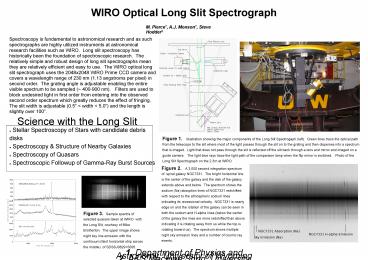WIRO Optical Long Slit Spectrograph PowerPoint PPT Presentation
1 / 1
Title: WIRO Optical Long Slit Spectrograph
1
WIRO Optical Long Slit Spectrograph
M. Pierce1, A.J. Monson1, Steve Hodder2
Spectroscopy is fundamental to astronomical
research and as such spectrographs are highly
utilized instruments at astronomical research
facilities such as WIRO. Long slit spectroscopy
has historically been the foundation of
spectroscopic research. The relatively simple
and robust design of long slit spectrographs mean
they are relatively efficient and easy to use.
The WIRO optical long slit spectrograph uses the
2048x2048 WIRO Prime CCD camera and covers a
wavelength range of 230 nm (1.13 angstroms per
pixel) in second order. The grating angle is
adjustable enabling the entire visible spectrum
to be sampled ( 400-900 nm). Filters are used
to block undesired light in first order from
entering into the observed second order spectrum
which greatly reduces the effect of fringing.
The slit width is adjustable (0.5 lt width lt
5.0) and the length is slightly over 100.
- Science with the Long Slit
- Stellar Spectroscopy of Stars with candidate
debris disks - Spectroscopy Structure of Nearby Galaxies
- Spectroscopy of Quasars
- Spectroscopic Followup of Gamma-Ray Burst Sources
Figure 1. Illustration showing the major
components of the Long Slit Spectrogaph (left).
Green lines trace the optical path from the
telescope to the slit where most of the light
passes through the slit on to the grating and
then disperses into a spectrum that is imaged.
Light that does not pass through the slit is
reflected off the slit back through a lens and
mirror and imaged on a guide camera. The light
blue rays trace the light path of the comparison
lamp when the flip mirror is switched. Photo of
the Long Slit Spectrograph on the 2.3m at WIRO.
Figure 2. A 3,000 second integration spectrum
of spiral galaxy NGC7331. The bright horizontal
line is the center of the galaxy and the disk of
the galaxy extends above and below. The spectrum
shows the sodium (Na) absoption lines of NGC7331
redshifted with respect to the atmospheric sodium
lines indicating its recessional velocity.
NGC7331 is nearly edge on and the rotation of the
galaxy can be seen in both the sodium and H-alpha
lines (below the center of the galaxy the lines
are more redshifted than above indicating it is
rotating away from us while the top is rotating
toward us). The spectrum shows multiple night
sky emission lines and a number of cosmic ray
events.
Figure 3. Sample spectra of selected quasars
taken at WIRO with the Long Slit, courtesy of
Mike Brotherton. The upper image shows night sky
line emission with the continuum (faint
horizontal strip across the middle) of
SDSSJ08295006.
1. Department of Physics and Astronomy,
University of Wyoming 2. AS Machine Shop,
University of Wyoming

